13 Apr 2012
Sarasota Opera’s 2012 Winter Festival
Opera-goers have come to expect high quality opera as part of Sarasota Opera’s Winter Festival.

Opera-goers have come to expect high quality opera as part of Sarasota Opera’s Winter Festival.
They have also come to expect a performance of a Giuseppe Verdi rarity, or at least a richly stylized version of a well-known work as part of the company’s Verdi cycle. Opera-goers in Sarasota are also used to the lasting presence of Victor DeRenzi leading their orchestras. This season, Sarasota Opera and the Maestro celebrate his thirtieth anniversary with the company.
A chance to catch Verdi’s Otello is cause for excitement anywhere; interest is heightened for such a thing in Sarasota, where Verdi is like an adopted patron saint. Begun in 1989, the company’s Verdi cycle is four operas shy of its ambitious endeavor to be “the only company in the world to have performed every note Giuseppe Verdi ever composed,” according to program information. Mounting Otello is such the challenge that many companies simply ignore it as repertoire. There is the problem of there being, or finding, an Otello that can do the role justice, and the memory of those that have is hard to erase.
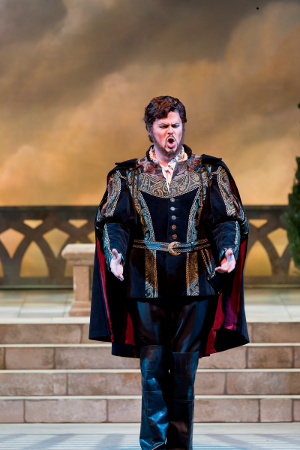 Sean Anderson as Iago
Sean Anderson as Iago
Rafael Davila’s performance of Otello comes with a few asterisks. Davila is, as far as this writer is concerned, on a very short list of tenors that are capable of sporting the naval jacket of Pinkerton and donning the “Lion of Venice” robe of Otello within five month’s time, performing both satisfyingly. More remarkable is this, on opening night March 3, was the Puerto Rican tenor’s first assumption of the role. It will be a treat to hear Davila’s Otello in other theaters. Davila will make first appearances with Washington National Opera as Pollione and in Bilboa as Ismaele (Nabucco) later this year. Otello is a real marathon, so when Davila came out and made a statement for “Esultate” — the singing was secure, had good weight and there was careful communication with the pit for the tricky note patterns — the memory of others that did not make it past the second act came to mind. Davila’s singing was caressing, with lines shaped in untraditional ways for the duet. In Act II, Davila delved into Otello’s insecurities while his voice continued to expand in expressiveness, pinging out B naturals and riding the passagio with clear tone. Davila simply patted some of Otello’s lower passages.
It is one thing to bluster through with power as some Otellos are like to do, another to pierce through the orchestra and sing mellifluously as Davila did. In “Dio mi potevi scagliar,” Davila expressed heartbreak and defiance; “Nium mi tema” was every bit a last gasp of love. Otello’s asides to Desdemona in act three were carried out excellently — Davila changed both tension and volume of voice without a hitch. This performance was missing, waiting for it, a tugging hostile polarity between Otello and Iago.
Some would argue that finding, or making, an Iago is a greater problem in casting this opera. In the early stages of its development, Otello’s librettist Arrigo Boito and Verdi only half-jokingly considered naming it after the vile ensign. Much of the challenge in the role of Otello lies in matters vocal; Iago has some difficult music to be sure, but it is in the psycho-drama, in Iago’s sowing seeds of malice, in his mutually disgusting and seducing, that this opera turns into a mesmerizing show. Verdi believed that in Iago, Shakespeare “invented the truth.” The most accomplished of baritones have fallen short of finding the truth in Iago.
Davila and Sean Anderson (Iago) have worked together before. Anderson is another Sarasota Opera perennial — he was a terrific John Proctor in The Crucible here last season. If Anderson gets any other opportunities to go deeper into Iago, he might could connect the text and method in the profound way he did with Proctor. Anderson’s singing was steady, with some highlights — the drinking song was like a warm-up (with little fun and a few ratty downward scales). Iago’s satisfaction over bringing down the Moor was well-announced but when Anderson gingerly floated his boot over Davila, setting it down gently, Iago became awkwardly maudlin over menace.
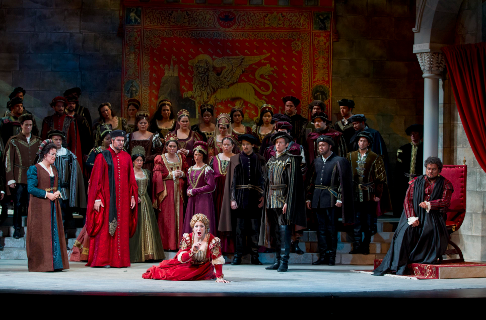 Maria D’Amato as Desdemona
Maria D’Amato as Desdemona
The Sarasota Opera chorus, with Roger L. Bingamen chorus master, takes any show here to another level. In Otello, the chorus came in strongly — both musically and in acting — just after Otello’s entrance. Then, they were on — shadings and dynamics for the storm were of great attention to detail, as was the fanfare of act three.
The role of Desdemona is in some ways remote, with motivations and inclinations in an alternate universe compared to those of the defending Italians and maraudering (though hapless) Turks. Desdemona has to communicate this distance, and the heart break and twisting frustration she suffers from not understanding the world Shakespeare has put her in. Maria D’Amato, in long glossy blonde curls, sang beautifully, displaying desperate desire for closeness to Otello early on, and for mercy and understanding up to her death bed. Her “Willow song” and “Ave Maria” were all those things that must be — prayerful and giving, and with the will to ask for what one wants.
As Cassio, Heath Huberg (who reappears and puts on lovely French for Remendado in Carmen this season) did a fine job, unsuspectingly playing into Iago’s hands in a role that’s launched the principal part career of many a tenor. Mathew Edwardsen’s Roderigo was effective as Iago’s clumsy tool — his fight (choreographed by Brian Robertson and staged by Stephanie Sundine) with Huberg was lively plus. It felt as though Cynthia Hanna, a Studio Artist with the company, was often separated from the goings-on as Emilia. Other Studio Artists took the roles of the Herald (Dinitre Lazich), Lodovico (Jeffrey Beruan), and Montano (Stephen Fish).
The orchestra sounded in much better shape accompanying singers in arias than in instrumental sections or playing for the chorus. The storm scene was an exception: the ebbs and flows and stridency of a tempest were captured by finely coordinated string and horn sections. The rather fast tempo set by Maestro DeRenzi rarely varied but he rarely missed an opportunity to spin a line movingly, or powerfully, along with singers — the “Un bacio” line (the “Kiss” motif) had more depth each time played, the “Credo” was finely timed, “Dio mi potevi scagliar” was shaped with deference for Davila’s stage position and actions, and in the “Canzone del Salice” the orchestra mourned as if pitying Desdemona.
“Others have ceded their places to us and we must cede ours to still others. I am more than happy to give mine to people of talent like Verdi,” Gaetano Donizetti wrote. As we know, Verdi ran with that baton — putting Otello to opera much later. It was a time that bore similarities to today; the public was crazed over what it wanted. Today that means new applications, and successively smart and smarter electronic devices. Back in the mid-19th century, the public frothed at the mouth for more opera. At this Verdi was ready and willing to oblige; Donizetti fared less well and history will say that he buckled under the pressure of producing opera to meet the perceived demand. He ended up institutionalized, a similar consequence that befalls Donizetti’s best known operatic creation: Lucia.
Lucia di Lammermoor represents a plot on the operatic timeline, of which Otello is beneficiary and derivative. Lucia and Otello then are linked beyond the two running together in repertory as is the case this season in Sarasota.
The opening scene of Lucia — bearing a few similarities to Otello’s opening story — all the way through the first scene of act two was tepid in this performance (on March 2). That changed in scene two — the chorus sprang to life with full sound and more movement. Brain Robertson (visiting stage director) was in on lifting the action: the chorus knelt as Raimondo finished telling of the horror he just witnessed. It was surreal but effective.
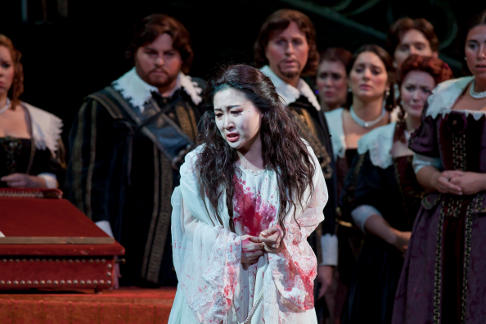 Kathleen Kim as Lucia
Kathleen Kim as Lucia
As far as keeping interest stimulated, the flute took up that responsibility. Marie Tachouet (principal flutist) and Kathleen Kim, the Lucia, paired note-for-note through familiar music and unconventional ornamentation. "I worked with my teacher on cadenzas first. I didn't want to limit myself to the ‘traditional way.’ So, we tried to find and create cadenzas that suit my voice; fresh and effective in the boundary of the style. When I met Maestro Barrese, of course, he had a few ideas. So we shared what we each had and came up with to create what has become final product." Visiting conductor Anthony Barrese’s ideas here are grounded in flexibility: “it [the cadenza] should have definite points of improvisation (in the beginning section whatever Kathleen sings the flute mimics, and this process is reversed at the end. Both the singer and flautist have been encouraged to change this up from night to night.)” “as the flute gains ascendancy, it simultaneously reflects the dramatic idea that "madness" has taken over, while providing Kathleen time enough to recoup for her final high note."
In Sir Walter Scott’s novel, Lucy is 17 years old and it is on that account that Ms. Kim so well characterizes Lucia. A Metropolitan Opera regular of late, the “tiny dynamo” — as Kim has been referred to — lent an adolescent quality to her parlando as the Scottish girl caught in a desperate situation. Kim’s light sound, constrained on high this evening, has no problem being heard.
Joshua Kohl (Edgardo) produced an inconsistent sound. Enough was heard though to describe it as quite attractive when produced cleanly. Kohl seemed to thrive with others on stage, doing well across the board up to the and after the Tomb scene which was shaky; he fumbled through “Fra poco a me ricovero.” When others entered the cemetery, Kohl’s singing was again quite lovely — his cries at “nume in ciel” were sung beautifully. Lee Poulis, Sarasota’s Giovanni last year, put his pointed baritone to work as Lord Enrico Ashton. Sarasota perennial Young-Bok Kim’s Raimondo was workmanlike, as were the Arturo of James Chamberlain (whose makeup shiny and campy), the Alisa of Daryl Freedman, and the Normanno of Steven Uliana, the latter three Studio Artists with the company.
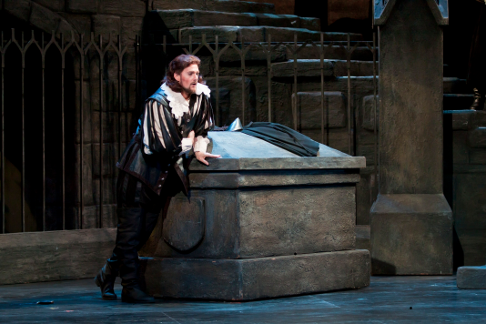 Joshua Kohl as Edgardo
Joshua Kohl as Edgardo
Lucia’s last act is noteworthy as far as set designs (Robert O’Hearn) go this season in Sarasota. The island-style tomb, upstage-right, and the cloudy ambiance were of fine visual quality, with care for audience sightlines and depth in features (carvings and shadows).
As Donizetti did in making way for Verdi, Verdi made way for others. Even if he seemed to object to “symphonic” biases creeping into opera composition, Verdi understood such things were inevitable. Georges Bizet was probably in that group of composers Verdi thought were refashioning the making of operatic music. But, Verdi’s Otello and Bizet’s Carmen are alike in significant ways.
On the operatic timeline, the operas are separated by a mere 12 years. They are both leitmotif driven; where Otello has the “Kiss” theme, Carmen has the “Fate” theme. One big difference has to do with the developments at the time of recitative in opera, spoken parts and different operatic cultures, as found in Carmen. In this dynamic is where this performance (a matinee on March 4th) of Carmen was distinguished.
DeRenzi chose to go with the original spoken dialogue the Opera Comique audience heard at Carmen’s first showing in 1875. This can give Carmen another life: the “mental massage” is in full force and tells a little of Bizet’s talent for comedy. An emphasis on language favors artists who have an affinity for it, and this cast had a few ringers. The level of French never strayed lower than good and there were a few examples of Francais delicieuse, some of the most delicious produced by bass-baritone Stephen Fish as Zuniga.
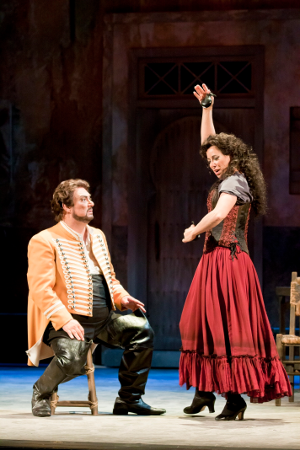 Antonio Nagore as Don Jose and Fredrika Brillembourg as Carmen
Antonio Nagore as Don Jose and Fredrika Brillembourg as Carmen
Fredericka Brillembourg’s French was sassy and spirited, her Carmen cold and fun. In the mountainous outskirts of Seville, gypsy women would have clawed each other’s eyes out for the right to a man. After, they would be like sisters, commiserating and using their wiles to survive — this came through in the connection between Brillembourg and Studio Artists Sarah Asmar (Frasquita) and Vira Slywotzky (Mercedes). Their hugging, stealing whispers, and ease in sharing space with each other — due to the work of Martha Collins (stage director) and Carolina Esparza (choreographer) — also distinguished.
The Don Jose of Antonio Nagore, a native Arizonian, was very much a characterization driven by voice, a good job of casting. Nagore’s spinto was beefy and proved durable. The Escamillo of Carlos Monzon was a case of characterization by looks. The Mexican bass-baritone was all hot-blooded Hispanic, with oily slicked-back bun and dark olive skin. Danielle Walker made some beautiful music in “Micaela’s song” and was not completely absent from the story as can happen with this role.
The rest of the events onstage contributed to the comedy — other soldiers played inept, other gypsies scheming, the gypsy smugglers, also inept. The group of kids assembled by Youth Opera chorus master Jesse Martins had a raucous good time making good music and fun.
DeRenzi’s treatment of Carmen was more “big-picture” than in Otello and paced just as evenly. The orchestra, wavering as woodwind playing was right at the start, took Carmen as a whole. In Carmen this meant playing to the different parts without too much emphasis on showpieces; there were light strings and muted horns for the fate motif and Carmen’s solos were as much for the orchestra, and even more so for the words, to shine. The “Flower song” was another example of this — the volume and intensity was restrained in returning to the tonic (fate motif) and at the peak of the vocal line. The one moment where the orchestra notably let loose was at the entr’acte of act three.
David P. Gordon’s first act (the square in Seville) was an example of a fine job making the most — using small staircases and wells, and tiered walkways — out of closed quarters.
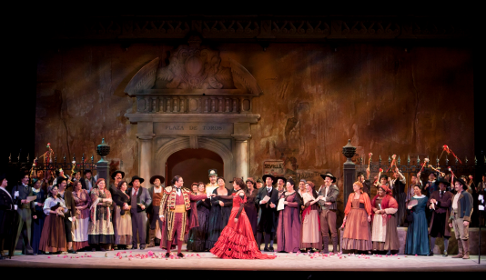 Scene from Act IV of Carmen
Scene from Act IV of Carmen
Sarasota Opera’s interest in continuing to rouse audience expectation led to the American Classic Series begun in 2011. The project goal is to present the operas of American composers. This season, Samuel Barber’s Vanessa ran from March 10th through the 24th.
As far as expectations go, visitors to Sarasota in March can bet on more than just opera, and Verdi, to welcome them; expect sunny days, soothing breezes off the gulf, and powder soft sand on fantastic beaches. In so far as there existed a timeline plotting the production of high quality opera, Sarasota Opera will stand apart as an example of what opera could be in the early part of the 21st century.
Robert Carreras